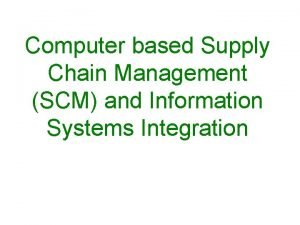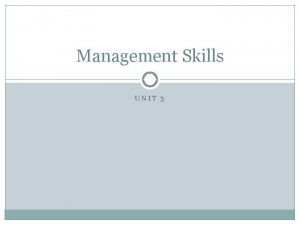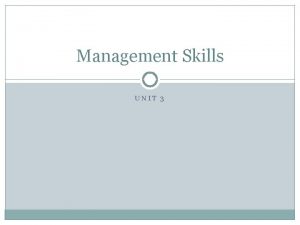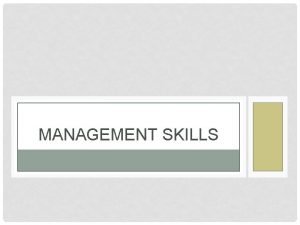CHAPTER 6 Management Skills 1 Leading LEADING Leading





















- Slides: 21

CHAPTER 6: Management Skills 1: Leading

LEADING • Leading is a management skill that encourages people to work towards a specific goal.

LEADING A strong leader must be able to: • Clearly communicate business goals to all staff • Find ways to motivate employees to achieve these goals • Set an example to employees • Delegate tasks to staff

LEADERSHIP STYLES There a number of leadership styles that managers can use to achieve organisational goals. The most common styles are: 1 Autocratic 2 Democratic 3 Laissez-faire

1 Autocratic Leadership • Autocratic leadership is a management style where the manager makes all business decisions without input from employees.

Features of Autocratic Leadership A Authority • Autocratic leaders have complete power and control in the organisation. B Decision-making • Autocratic leaders do not consult with employees when making decisions. C Trust • They do not trust employees and may believe that they are lazy and try to avoid work. D Motivation • Autocratic leaders use threats and punishment to motivate their employees to work harder.

AUTOCRATIC LEADERSHIP Advantages 1 Quick Decision-making Decisions can be made quickly as the autocratic leader does not consult with others. Therefore, the business does not miss out on opportunities in the market. 2 Quick Task Completion The autocratic leader gives orders to staff to ensure that tasks are completed quickly and deadlines are not missed. 3 Improved Productivity Employees work hard as they know that they are being supervised by management. This can improve productivity in the workplace. Disadvantages 1 Management Stress The autocratic leader makes all business decisions and does not delegate tasks. This can lead to management stress and burnout. 2 Staff Motivation levels are low as staff follow orders and jobs are not delegated to them. This can lead to higher absenteeism and staff turnover. 3 Industrial Action Employees may feel undervalued, which damages the relationship between management and employees. This may lead to increased industrial action, e. g. work to rule and official strikes.

2 Democratic Leadership • Democratic leadership encourages employees to participate in decision-making in the business.

Features of Democratic Leadership A Authority • Democratic managers delegate tasks to employees. However, ultimate responsibility for all tasks lies with the manager. B Decision-making • Democratic leaders include employees when they make business decisions. C Trust • Democratic leaders trust their employees and empower them to make decisions on behalf of the business. D Motivation • Employees are motivated as they feel valued when they are delegated tasks and are involved in decision-making in the business.

DEMOCRATIC LEADERSHIP Advantages Disadvantages 1 Increased Intrapreneurship Employees are willing to come up with ideas that can help the business to increase sales or decrease business costs, e. g. a new product. 1 Slow Decision-making is slow as managers consult with their employees before making major business decisions. 2 Future Promotion Delegation and empowerment help employees to develop new skills and knowledge. When promotions arise in the business they can apply for these roles. 2 Frustrated Employees may feel frustrated if their ideas are not incorporated into business decisions. They may decide not to contribute their ideas in the future. 3 Employee Motivation Employees have high levels of motivation, as they feel valued. This can lead to higher productivity levels among staff. 3 Management Resentment Some managers may resent empowering employees, as it reduces their control in the business.

2 Laissez-faire Leadership • Laissez-faire leaders take a hands-off approach to employees and allow them to make decisions that they believe are in the best interests of the business.

Features of Laissez-faire Leadership A Authority • Laissez-faire managers set goals for employees and allow staff to decide how best to achieve those goals. B Decision-making • Laissez-faire managers empower employees to make decisions on behalf of the business. C Trust • Management outlines the business objectives and trusts employees to work independently without close management supervision. D Motivation • Employees are highly motivated under this style of leadership, as they feel empowered to achieve the firm’s goals.

LAISSEZ-FAIRE LEADERSHIP Advantages Disadvantages 1 Employee Motivation Employee motivation is high among empowered employees, as they feel trusted by management. They work hard for the benefit of the business and to achieve the firm’s goals. 1 Reduced Productivity Some employees may take advantage of the lack of regular management supervision. This can create tension among team members and reduce business productivity. 2 Improved Skills and Knowledge Delegated work helps employees to improve their skills and knowledge. This prepares them for future promotions in the business. 2 Poor Decisions Some employees can make poor decisions that damage the firm’s reputation or result in a business missing an opportunity in the market. 3 Intrapreneurship Employees use their intrapreneurial skills to develop new products or identify new processes. This can help to reduce business costs and improve sales. 3 Poor Industrial Relations Management may blame employees for mistakes made or for not achieving targets. This can lead to poor industrial relations between management and staff.

DELEGATION • Delegation involves assigning tasks to another person, e. g. a manager delegates tasks to a subordinate.

Requirements for Delegation Open communication Employee skills and experience Managerial control

Requirements for Delegation 1 Open communication • Delegated tasks and the required standards should be clearly communicated to employees. 2 Employee skills and experience • Management must choose employees with adequate skills and experience to complete the assigned task. 3 Managerial control • Ultimate responsibility for task completion lies with management. Therefore, managers must implement a control system to ensure that errors are identified and corrected quickly.

Advantages of Delegating Advantages 1 Management Workload Delegation reduces managerial workload and allows managers to focus their time on more important managerial tasks and decisions. 2 Increased Employee Motivation Delegating tasks to employees shows that management trusts them. Increased motivation can help to boost productivity in the workplace. 3 Management Training Delegation gives employees the opportunity to develop their skills and knowledge and helps them to train as managers.

Disadvantages of Delegating Disadvantages 1 Employee Stress Some employees may not want the additional responsibility of delegated tasks and may become stressed and want to leave the firm. 2 Poor Decision-Making Employees lacking experience and suitable guidance may make poor decisions when they receive delegated tasks. This could damage the firm’s reputation. 3 Employee Resentment Employees may resent management if they feel that the delegated tasks are simply tasks that the manager does not like to do.

BENEFITS OF LEADERSHIP 1 Achieving organisational goals 2 Management time 3 Increased employee motivation 4 Supporting change 5 Staff recruitment and retention

Key Terms • leading • leadership styles • autocratic leadership • • democratic leadership empowerment laissez-faire leadership delegation

CREDIT SLIDE • Shutterstock • i. Stockphoto. com • Alamy. com
 Bobbin leading and flyer leading
Bobbin leading and flyer leading Intrapersonal skills examples
Intrapersonal skills examples What are the skills
What are the skills Skills passport
Skills passport Chapter 5 principles of voice leading answers
Chapter 5 principles of voice leading answers Chapter 1 leading a healthy life answers
Chapter 1 leading a healthy life answers Leadership speech
Leadership speech Chapter 1 leading a healthy life
Chapter 1 leading a healthy life Top management middle management first line management
Top management middle management first line management Top management middle management first line management
Top management middle management first line management Top level management
Top level management Operations management chapter 12 inventory management
Operations management chapter 12 inventory management Stress management life skills
Stress management life skills 3 management skills
3 management skills Mid level management
Mid level management 3 management skills
3 management skills Anger management skills
Anger management skills Hrm practices
Hrm practices Self management skills meaning
Self management skills meaning Management skills
Management skills Scm in computer
Scm in computer Stress management life skills
Stress management life skills








































